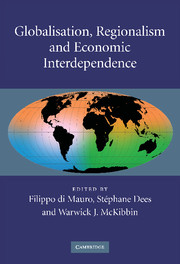Book contents
- Frontmatter
- Contents
- List of figures
- List of tables
- List of contributors
- Preface
- Introduction
- 1 International linkages in the context of global and regional integration
- 2 Trade integration of the central and eastern European countries and China: has it reached potential?
- 3 Patterns and determinants of production fragmentation in world manufacturing trade
- 4 Going global: trade, internationalisation of production and domestic performance of euro area firms
- 5 Globalisation and the trade channel in the euro area
- 6 Gauging the labour market effects of international trade openness: an application to the US manufacturing sector
- Index
Preface
Published online by Cambridge University Press: 02 September 2009
- Frontmatter
- Contents
- List of figures
- List of tables
- List of contributors
- Preface
- Introduction
- 1 International linkages in the context of global and regional integration
- 2 Trade integration of the central and eastern European countries and China: has it reached potential?
- 3 Patterns and determinants of production fragmentation in world manufacturing trade
- 4 Going global: trade, internationalisation of production and domestic performance of euro area firms
- 5 Globalisation and the trade channel in the euro area
- 6 Gauging the labour market effects of international trade openness: an application to the US manufacturing sector
- Index
Summary
One of the main features of recent times has been the establishment of new major players in world markets amid the rapid diffusion of information technology. With emerging Asia, as well as central and eastern European countries, rapidly integrating in a more globalised economic setting, worldwide competition has sharpened, also leading to major changes in the structure of international trade. While globalisation was unfolding, regionalisation, another – possibly older – process was gaining momentum as well, most notably in Europe. How are these two processes interrelated, though? Are they complementing or contradicting each other?
To be sure, globalisation and regionalism are not mutually exclusive and cannot be seen in isolation from each other. Both encompass a strong increase in cross-border transactions in goods and services, capital, labour and natural resources. Both imply a dramatic change in the international transmission of shocks and in the ways that economies relate to their international environment. Both confer clear economic benefits, but there are also significant challenges to face.
At the ECB we are well aware of such issues, and in 2005, together with the Lowy Institute for International Policy and the Centre for Applied Macroeconomic Analysis at the Australian National University, we jointly organised the conference ‘Globalisation and Regionalism’. Drawing partly from this conference, the book edited by di Mauro, Dees and McKibbin sets out to reply to the above-mentioned questions from both an academic and a policy-oriented viewpoint.
- Type
- Chapter
- Information
- Globalisation, Regionalism and Economic Interdependence , pp. xiii - xivPublisher: Cambridge University PressPrint publication year: 2009



